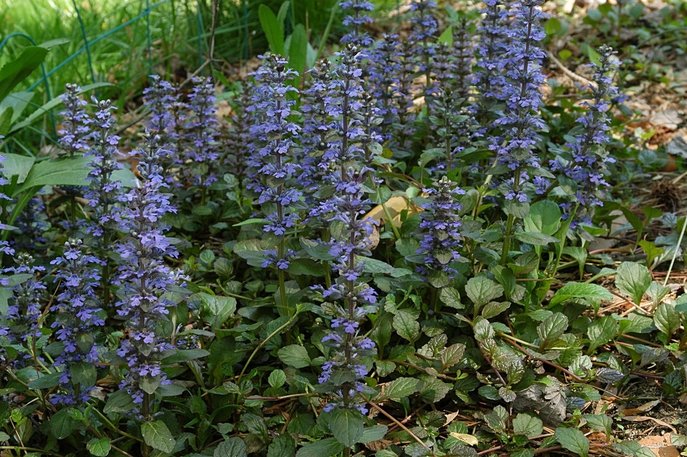Bugleweed (Ajuga Reptans)
|
Garden Bugleweed (Ajuga reptans)
Common names: Bugle, blue bugle, bugleherb, bugleweed, carpetweed, carpet bugleweed, and common bugle, and traditionally but less commonly as "St. Lawrence plant". Genus: Ajuga (a-JOO-guh) Family: Lamiaceae (lay-mee-AY-see-ee) Species: reptans (REP-tanz) Type: Perennial. Attracts bees. NOTE: All parts of plant are poisonous if ingested. Hardiness: USDA Zone 3 - 9 Bloom Time: semi-evergreen, flowers late spring/early summer Exposure: Sun to full shade Height: 2" to 4" tall when not in bloom, but rises to 10" tall when in flower. Spread: 5 - 8 inches. Description: Ajuga reptans, commonly called bugleweed, or carpet bugleweed is a rapidly spreading, mat-forming ground cover which features shiny, dark green leaves and small, lavender-blue flowers on 3.9–5.9 in stalks. A member of the mint family, some cultivars of this species feature variegated leaves. Dense foliage will choke out weeds. Not particularly tolerant of foot traffic. Cultivation: Space 12" apart. Space plants 6-9” apart for prompt cover. Fertilize: Lightly in early spring with a low-nitrogen fertilizer such as 5-10-5. Soil and pH: Prefers moist, humusy, well-drained soils with good drainage, but tolerates moderately dry ones. 6.1 to 6.5 (mildly acidic) 6.6 to 7.5 (neutral) 7.6 to 7.8 (mildly alkaline) Watering: Water regularly, do not over-water. Pests/Diseases: Few insect or disease problems. Crown rot can be a problem, particularly in the humid conditions of the deep South and in heavy soils. Avoid planting in wet, heavy soils, provide good air circulation and divide when clumps become overcrowded. Also avoid planting near perennial beds or lawns where its spreading nature could pose removal problems. Propogation/Transplanting: Self-propagates by runners. or by transplanting of daughter plants from rooted runners, or by crown division. Notes/Gardening Tips: Vigorous, spreading plants bloom in May or June. Use as a ground cover for lightly shaded areas, edging for borders, or in the cracks of a patio. Ajugas spread rapidly under good conditions. Some varieties spread more aggressively than others. Will grow in full shade, but best foliage color usually occurs in part-sun locations (at least 3-4 hours of sun per day). Provide good air circulation in hot and humid areas where crown rot is a problem. Divide plants if they become overcrowded. Spreads by stolons (reptans means creeping) to form an attractive, mat-like ground cover. Plants may be cut back to the ground after flowering, if necessary, to rejuvenate the foliage. On variegated forms promptly remove any non-variegated leaves that may appear. Variegated forms will slowly revert to green or bronzed foliage forms unless the non-variegated sports are periodically removed Primary use is as a ground cover. Will fill in large, shady areas where other plants or grasses might be difficult to establish. May also be planted on banks or slopes, under trees or around shrubs. Can be planted over spring bulbs such as snowdrops (Galanthus). Can crowd out other plants. Good for small spaces, containers and rock gardens. |

